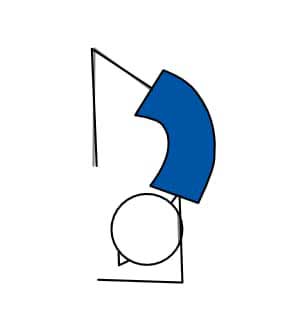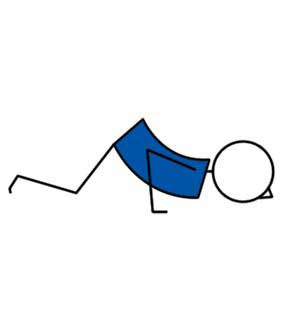
Scorpion
| Sanskrit Name: | Vrischikasana |
|---|---|
| Similar Pose Names: | Forearm Stand Scorpion,Thigh Stand |
| Category: | Seated & Floor |
| Share on: |
 Yoga Lesson Planner
Yoga Lesson Planner
 Pilates Lesson Planner
Pilates Lesson Planner
| Category: | Yoga Lesson Planner |
|---|---|
| Sub Category: | Seated & Floor |
| Types: | Animal, Arm Balance, Balance, Forward Bend, Hip Opener, Inversion, Prone, Seated & Floor, Strengthen |
| Anatomy: | Arms & Shoulders, Biceps & Triceps, Core, Hamstrings, Hips, Psoas, Wrists & Arms |
| Chakras: | Crown Centre, Heart Centre, Solar Plexus Centre, Throat Centre |
| Therapy: | Confidence Building |
| Drishti: | Tip Of Nose |
| Dosha: | Kapha, Pitta |
Start in a forearm stand with your arms shoulder-width apart. Gently arch your back, bend your knees, and extend your toes towards your head, keeping your core engaged and shoulders strong. Use controlled breaths. Practice near a wall or with a spotter for safety.
Enhances spine flexibility, strengthens shoulders and core, improves balance, boosts circulation, and nurtures concentration and mental fortitude.
1) In Dolphin Pose hold an inverted V-shape on forearms, alternate lifting legs to enhance balance. 2) In Forearm Plank hold a straight line from heels to head. 3) In Bridge Pose lift into a backbend, pressing feet and shoulders down, opening the chest.
Folded blanket as a crash mat.
Click here for lots of FREE downloadable Yoga lesson plans.
Click here for lots of FREE downloadable Pilates lesson plans.
10 Scorpion Pose (Vrischikasana) Theme Ideas That You Can Use In Your Next Yoga Class
Yoga class themes add a bit of fun and creativity to a yoga class.
Scorpion Theme 1: Embracing Transformation
Explore the transformative power of Vrischikasana, symbolizing the scorpion’s ability to shed its skin and embody renewal and growth.
Scorpion Theme 2: Cultivating Resilience
Focus on building the inner strength and resilience required to balance in Scorpion Pose, reflecting on life’s challenges and our capacity to rise above them.
Scorpion Theme 3: Overcoming Fear
Use the intimidating nature of Scorpion Pose to discuss overcoming fears, both on the mat and in daily life, fostering courage and confidence.
Scorpion Theme 4: Striking Balance
Highlight the balance between effort and surrender in Vrischikasana, mirroring the quest for equilibrium in our personal and professional lives.
Scorpion Theme 5: Flexibility and Adaptability
Draw parallels between the physical flexibility needed in Scorpion Pose and the mental adaptability required to navigate life’s constant changes.
Scorpion Theme 6: Precision and Patience
Encourage a practice focused on the meticulous alignment and patient approach that mastering Scorpion Pose demands, applicable to achieving goals in life.
Scorpion Theme 7: The Power of Vulnerability
Discuss the vulnerability of the heart-opening aspect of Scorpion Pose, learning to be open and receptive without fear of emotional stings.
Scorpion Theme 8: Poise Under Pressure
Consider the poise Scorpion Pose requires despite the pressure of the inversion, analogous to maintaining composure during life’s ups and downs.
Scorpion Theme 9: Releasing Control
In Scorpion Pose, we must sometimes let go of control to find the pose’s sweet spot, teaching us to release the need for control elsewhere.
Scorpion Theme 10: The Sting of Growth
Acknowledge that growth can come with discomfort, much like the challenging sting of the scorpion, urging us to embrace the growing pains of personal development.
If you liked those themes, you might like these twenty modifications for Scorpion Pose.
20 Modifications For Scorpion Pose (Vrischikasana)
Modification 1: Forearm Plank
Build foundational strength by holding a forearm plank, focusing on core engagement and shoulder stability.
Modification 2: Dolphin Pose
Practice Dolphin Pose to strengthen the shoulders and upper back, preparing for the arm position in Scorpion.
Modification 3: Sphinx Pose
Begin with Sphinx Pose to start gentle back bending and open the chest without full inversion.
Modification 4: Puppy Pose
Stretch the spine and open the shoulders in Puppy Pose, a precursor to the backbend required in Scorpion.
Modification 5: Wall Scorpion
Use a wall for your feet in the Forearm Stand, gradually walking them down to mimic the Scorpion’s arch.
Modification 6: Strap Around Arms
Use a strap around your arms just above the elbows in the Forearm Stand to maintain proper alignment.
Modification 7: Elevated Forearms
Place forearms on blocks during Forearm Stand to lessen the bend in the back and ease into the pose.
Modification 8: One-Legged Scorpion
From the Forearm Stand, bend only one leg towards the head to reduce intensity and work on balance.
Modification 9: Scorpion Against Wall
Perform the pose with your back to the wall, allowing your feet to touch the wall as you bend.
Modification 10: Partner-Assisted Scorpion
Have a partner support your back or legs as you enter the backbend, providing stability and confidence.
Modification 11: Block Under Pelvis
Place a block under the pelvis in the Forearm Stand for support and to reduce the backbend.
Modification 12: Chair Support
Use a chair to support your feet in the Scorpion, reducing the depth of the pose.
Modification 13: Block Between Thighs
Squeeze a block between your thighs in the Forearm Stand to engage the legs and maintain alignment.
Modification 14: Scorpion in Headstand
Start with a Headstand, then carefully bend the knees to enter a less intense version of the Scorpion.
Modification 15: Half Scorpion with Raised Leg
Lift into a Forearm Stand, and extend one leg up while the other leg bends towards the head.
Modification 16: Scorpion Tail
Practice standing, bending backwards, and trying to touch one foot to the back of the head to mimic the Scorpion’s tail without inversion.
Modification 17: Camel as Prep
Perform Camel Pose to prepare the back for the deep bend required in Scorpion Pose.
Modification 18: Bow Pose
Lie on your belly and enter Bow Pose, focusing on opening the chest and bending the back.
Modification 19: Legs-Up-The-Wall
Lie on your back with your legs up the wall, bend your knees, and push your feet into the wall to simulate the Scorpion’s shape.
Modification 20: Supported Bridge
Enter a Bridge Pose with a block under the sacrum, lifting one leg at a time towards the ceiling to prepare for the inversion and backbend.
If you liked those modifications, you might like these twenty teacher “assists” for Scorpion Pose.
20 Teacher “Assists” For Scorpion Pose (Vrischikasana)
Assist 1: Foundation Check
Ensure the student’s forearms and elbows are properly grounded and shoulder-width apart for a stable base.
Assist 2: Shoulder Support
Gently press down on the student’s shoulders to encourage them to keep the area broad and stable.
Assist 3: Backbend Guidance
From behind, support the student’s back with your hands as they arch into the backbend, ensuring safety.
Assist 4: Hip Elevation
Place your hands on the student’s hips and guide them upward, which helps initiate the backbend.
Assist 5: Leg Lift Cue
Lightly touch the back of the student’s thighs as a cue to lift the legs into the pose.
Assist 6: Arch Enhancement
Help deepen the back arch by supporting the student’s spine with your hands while they press their chest forward.
Assist 7: Foot Direction
Guide the student’s feet towards their head for proper alignment of the scorpion tail.
Assist 8: Wall Spotting
Stand behind the students as they use the wall for support, ready to catch them if they lose balance.
Assist 9: Balance Check
Position yourself beside the student to spot and stabilize them as they find their centre of gravity.
Assist 10: Gentle Foot Pressure
Apply light pressure to the student’s feet to encourage the action of reaching back toward the head.
Assist 11: Controlled Descent
Support the student’s lower back or hips as they come out of the pose to ensure a controlled descent.
Assist 12: Safety Net Positioning
Provide a physical barrier with your arms or body in front of the student to prevent falling.
Assist 13: Heart Opener
Encourage the student to open their chest more by placing your hands on their upper back and guiding it forward.
Assist 14: Pelvic Tilt Correction
Help the student slightly tuck their pelvis to protect the lower back and maintain alignment.
Assist 15: Alignment Awareness
Assist in adjusting the student’s forearms parallel to each other, preventing them from angling outwards.
Assist 16: Spotter’s Stance
Adopt a ready stance to catch the student if they begin to fall out of the inversion.
Assist 17: Verbal Cueing
Provide clear verbal instructions on breathing and movement to guide the student into the pose.
Assist 18: Tailbone Lengthening
Encourage the student to lengthen their tailbone towards their heels to elongate the lower spine.
Assist 19: Head and Neck Care
Monitor the position of the student’s head and neck, ensuring they don’t compress or strain.
Assist 20: Engagement Reminder
Tap the student’s core area to remind them to engage their abdominals for added stability.
While you’re assisting your students in the pose, it’s important to let them know the amazing benefits of balance poses.
5 Benefits Of Balance Poses
Balance is the ability to control your body’s position, whether stationary (i.e. a complex yoga pose) or while moving (e.g. playing golf). Balance is a key component of Yoga, along with strength and flexibility poses.
Balance Benefit 1: Body Awareness
Body awareness is how your limbs are oriented in space, also known as proprioception. Balance training improves body awareness, which decreases the likelihood of injury.
Balance Benefit 2: Coordination
Balance poses require your entire body to work in harmony, otherwise, you will fall or stumble. Improved coordination during balance poses will be transferred into coordination in everyday life.
Balance Benefit 3: Joint Stability
Balance poses to promote stable knees, ankles, hips, and shoulders. This can prevent a multitude of injuries including sprained ankles and knee problems.
Balance Benefit 4: Reaction Time
Balance poses can improve your reaction time. If you happen to slip or stumble when performing balance poses, your body needs to re-balance immediately or you will fall. This in turn will improve your reaction time in everyday life.
Balance Benefit 5: Long-Term Health
Adding balance poses into your Yoga session helps to maintain or improve your balance, which is needed to prevent falls and fractures. As we age, our balance can deteriorate. Yoga balances will help delay that deterioration.





























